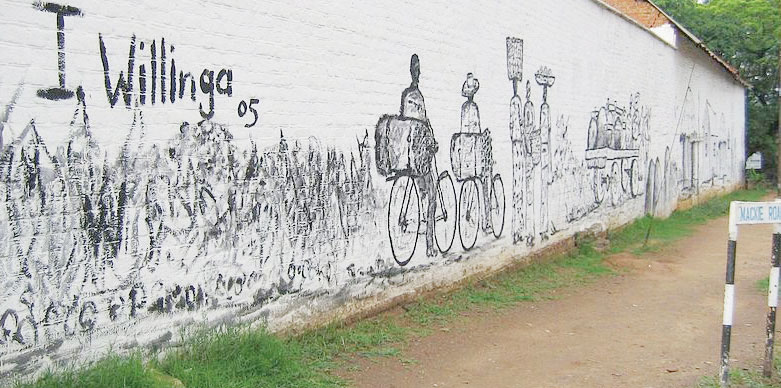Africa-Press – Malawi. The country on Wednesday woke up to the news of the death of well-known creative artist Innocent Willinga, who would have celebrated his birthday today.
His death has shocked the creative industry with many artists describing him as an artist with an unique style. For those who have followed art in the country, Willinga is the brains behind the mural that stands at Mandala in Blantyre.
Passing through Mandala, one would not skip sampling the work of art executed on a wall close to Jacaranda Cultural Centre and Cfao. Visual Arts Association of Malawi (Vaam) acting president Gilbert Mpakule on Wednesday described Willinga’s death as a great loss to the creative industry.
“We are saddened as Vaam to lose such a talented artist. He did a lot and his work speaks volumes of the immense talent he had. He did murals at Mandala and close to Ryalls Hotel. He was always there to share knowledge on art,” Mpakule said.
Godfrey Mphwanye from La Caverna, which also houses some of his works, said he was shocked with Willinga’s death. “Willinga was such a talented artist and we are saddened as La Caverna,” Mphwanye said.
UTM Party in its press statement signed by its publicity secretary Frank Mwenifumbo mourned Willinga describing him as an artist per excellence and a unique giant whose marvellous works of art “will live on long after you are gone”.
“Your gentle way of harnessing colours on different canvasses was so pure and brilliant. Malawi has lost a gifted and talented pair of hands, an original mind and a super gentle giant,” reads the statement.
Willinga was laid to rest in Bolero, Rumphi District Thursday. According to Robert Salijeni, a closed friend, Willinga was until his death one of the directors of Roof House.
Wilinga died of asthma and pneumonia at Queen Elizabeth Central Hospital in Blantyre. With murals not that popular in the country, Willinga was one of the figures in Malawi’s mural art.
“Art is my life and my daily fuel,” he said. Willinga in March this year also crafted paintings depicting events in isolation and the need to have friends around us. He wrote on his Facebook page that Covid has led to the disarmament of arts.
Over the course of time, murals have covered the interiors and exteriors of many public buildings, such as palaces, temples, tombs, museums, libraries, churches and the houses of rich art patrons, spreading onto the streets and architectural elements more recently, all the while keeping their initial meaning.
A mural is any piece of artwork painted or applied directly on a wall, ceiling or other permanent surfaces. A distinguishing characteristic of mural painting is that the architectural elements of the given space are harmoniously incorporated into the picture.
Some wall paintings are painted on large canvases, which are then attached to the wall This technique has been in common use since the late 19th century according to available information. Willinga told the media in 2016 that mural art was a new trade in the country but not alien.
“Mural art is only springing in Malawi at a slow pace because most corporates are only thinking of advertising and the walls spaces have been clad by such much as we all know many walls are dirty and for me they are blank canvas on which I can, after being granted permission by either banks or corporates, attack them with murals depicting many local and daily stories unlike graffiti artists who will do such illegally,” he said then.
On his artistry on the wall at Mandala and Ryalls, he described himself as a mural revolutionist in Malawi. He said his work at Ryalls is called ‘Quest for Clean City Walls’.
“It is a colour interplay depicting people in the formal and informal sector, keeping time. There is graphic on it which says ‘I Love Blantyre’ which only requires one to have the eye to pick it up,” Willinga said.
He said mural art was important in that it cleans the dirt and grime on walls. “It also makes our city to be in synch with outside world cities where this is the trend too, so we will seem to be moving with others out there,” Willinga said. The late Willinga studied art and design in South Africa.
“As an artist, I have the liberty to simply do paintings or go flat out to the city streets or banking halls which I am waiting to tackle since banks have people of all walks of life and why not remind them of what is important. We need to remember who we are,” he said then.
As a creative director through his Willingaart, he wrote of his projects on interior design and decoration. Born on June 25 1974, Willinga is survived by a wife and two children.






